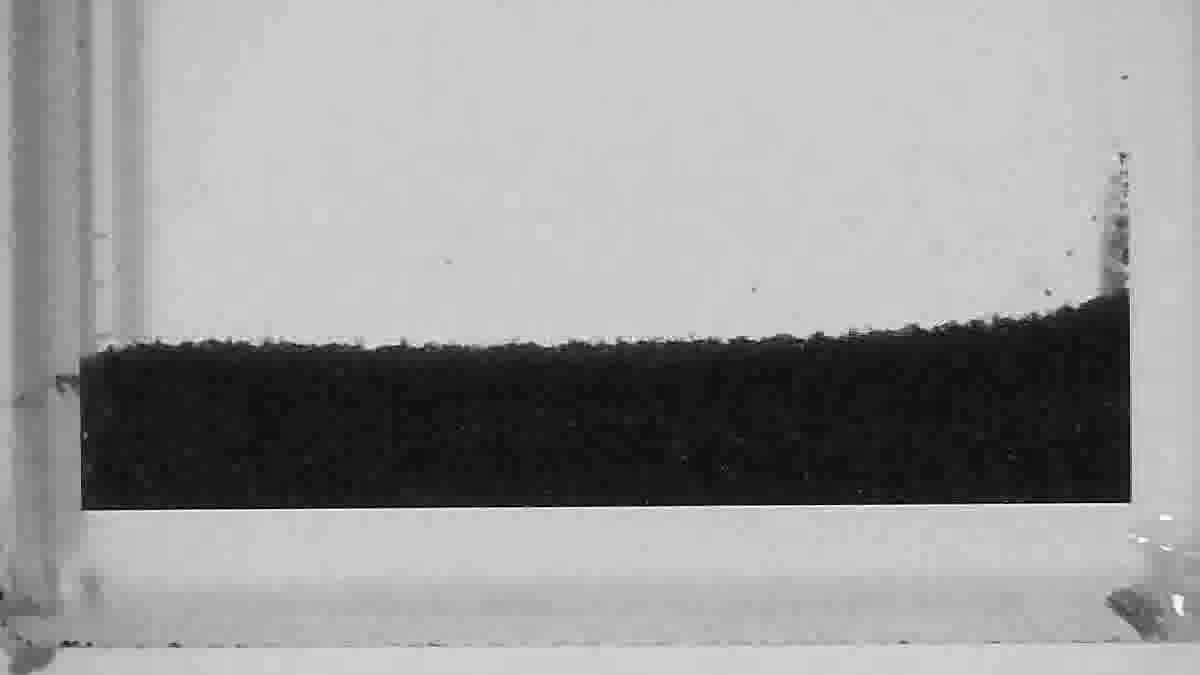
Impossible.
It was the first thought researcher James Gilchrist had as he watched his postdoc rotate a magnet beneath a vial of iron oxide–coated polymer particles and the grains began to move—uphill.
“I went nuts,” says Gilchrist, Lehigh’s Ruth H. and Sam Madrid Professor of Chemical and Biomolecular Engineering. “I was so excited because I’d never seen anything like it. Powders don’t flow uphill.”
His postdoc, Samuel Wilson-Whitford, who is now an assistant professor in engineering at the University of Warwick (UK), had made the discovery entirely by serendipity in the course of his research into microencapsulation. Wilson-Whitford is the lead author on a paper published in Nature Communications that proves the seemingly impossible.
“After using equations that describe the flow of granular materials,” says Gilchrist, “we were able to conclusively show that these particles were indeed moving like a granular material, except they were flowing uphill.”
After making their discovery, Wilson-Whitford and Gilchrist kept it under wraps for a while. The gravity-defying movement of the material—tiny, magnetically responsive particles that are similar to sand and called microrollers—was so unexpected, they couldn’t believe their eyes.
Wilson-Whitford made it a side project to his research, studying how the material reacted to the magnet under different conditions. Maria Chiara Roffin, a former Lehigh postdoc who is currently at Nottingham Trent University, helped with data analysis, and chemical engineering graduate student Jinghui Gao and then-undergraduate student William Buckley ‘22 helped with particle synthesis and preliminary analyses.
“These particles are really hard to make and scale up, so most people study a very small sample of microrollers, and in fact, there’s a body of literature of researchers who study single microrollers and how they move in response to a magnetic field,” says Gilchrist. “We probably make more of these particles than any other group in the world, and that allows us to look at the bulk properties of what is essentially a pile of sand.”
For example, he says, when they pour the microrollers without activating them with the magnet, they flow downhill. But once they apply torque using the magnets, each particle begins to rotate. The microrollers also have an attraction to each other, creating temporary doublets that quickly form and break up. The result, says Gilchrist, is cohesion that generates a negative angle of repose due to a negative coefficient of friction.
“Up until now, no one would have used these terms,” he says. “They didn’t exist. But to understand how these grains are flowing uphill, we calculated what the stresses are that cause them to move in that direction. If you have a negative angle of repose, then you must have cohesion to give a negative coefficient of friction. These granular flow equations were never derived to consider these things, but after calculating it, what came out is an apparent coefficient of friction that is negative.”
Friction matters a lot, he says. Increasing the magnetic force increases the cohesion, which gives the grains more traction and the ability to move faster. The collective motion of all those grains, and their ability to stick to each other, allows a pile of sand particles to essentially work together to do amazing, counterintuitive things—like flow up walls and even climb stairs.
“This first paper just focuses on how the material flows uphill, but our next several papers will look at applications, and part of that exploration is answering the question, can these microrollers climb obstacles? And the answer is yes.”
The team, with the help of Marietta Sisca ’23, is using a laser cutter to build tiny staircases, and is investigating how the material ascends one side and descends the other. A single microroller couldn’t overcome the height of each step, says Gilchrist. But working together, they can.
“It’s similar to the tread on a tank,” he says. “If you have one layer of particles rolling, there’s enough friction on those grains to allow the next layer to grab on, and roll over the top of them and climb the stairs.”
Potential applications could be far ranging. The microrollers could be used to mix things, segregate materials, or move objects. And because these researchers have discovered a new way to think about how the particles essentially swarm and work collectively, future uses could be in microrobotics, which in turn could have applications in healthcare. Gilchrist recently submitted a paper exploring their use on soil as a means of delivering nutrients through a porous material.
Indeed, the scope is so vast that fresh eyes are imperative to uncovering novel uses, says Gilchrist. He had seven undergraduates working as part of Lehigh’s Mountaintop Summer Experience who spent the entire summer simply experimenting with the materials and thinking about how they could be used.
“We’re studying these particles to death,” he says, “experimenting with different rotation rates, and different amounts of magnetic force to better understand their collective motion. I basically know the titles of the next 14 papers we’re going to publish.”
For Gilchrist, the discovery has brought him full circle as a researcher. He spent his PhD studying how granular materials flow, but soon moved into nanoscale science and has been there ever since.
“And now, 25 years later, someone in my own lab is showing me that the materials I studied so carefully for so many years for my PhD, can do exactly the opposite of what I thought they could do. That’s the mind-blowing part for me.
Learning that the impossible is indeed possible has also been profoundly rewarding. Engineers, he says, rarely “discover” in the strictest definition of the word. Rather, they tend to learn more about things they already know.
“The article received widespread interest across many news outlets. This is the closest I’ve ever come to being able to say I’ve discovered something new that no one has seen before, and that will open up new fields of study,” he says. “I didn’t expect that in my career I’d ever be able to say that.”


